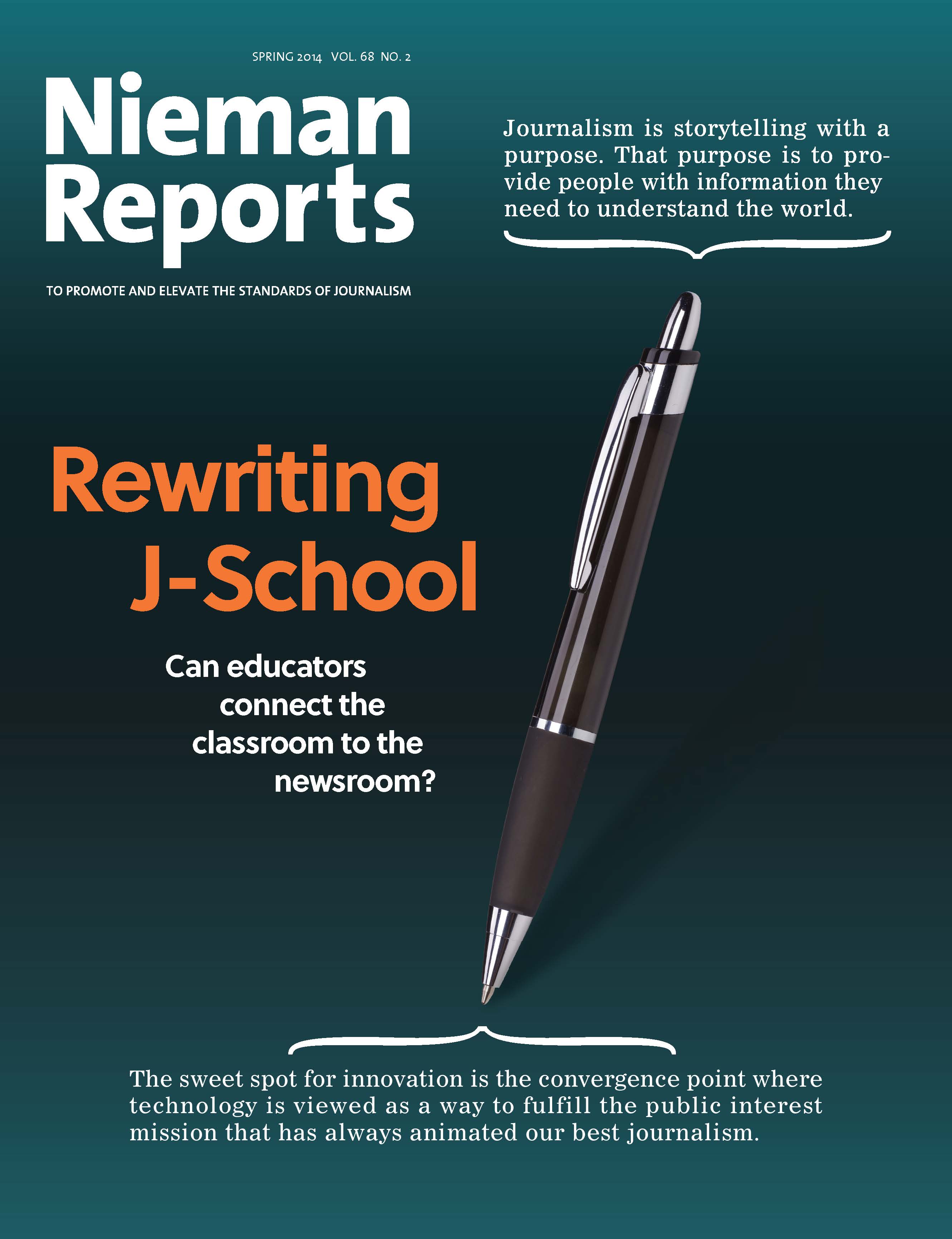
“Most things on the Web are too long,” BuzzFeed’s Ben Smith tells Susie Banikarim
When Ben Smith joined BuzzFeed as editor in chief in 2012, the site was better known for cute cat videos and fun lists than for serious journalism. Over the past two years, he’s hired more than 150 reporters and editors; the site now covers politics and business and has an investigative reporting team. It now attracts 130 million monthly unique visitors.
Before arriving at BuzzFeed, Smith was a well-established political reporter. He was an early hire at Politico and creator of some of the earliest New York City politics blogs, including the Politicker, which he started for the New York Observer in 2004. He began his career at The Indianapolis Star before moving to Latvia and reporting for the European edition of The Wall Street Journal.
Smith was interviewed by 2014 Nieman Fellow Susie Banikarim during a visit to Lippmann House earlier this year. Edited excerpts:
On attracting readers
Our view is that the bar is very high to do something that’s compelling enough to have someone actively decide to share it, not just to have somebody wander past page A7 and glance at it because that’s the newspaper that landed on their door. A lot of editors in the last decade learned that, “Oh, the Internet is this trick.” You can get the tech guys to SEO [search engine optimize] your stuff. Then you can get traffic. That’s exactly the wrong lesson for what turned out to be the next era, which was social, where you really can’t trick people intosharing things. They have to really like it and be proud to share it. Whether it’s a more traditional form of a story or a totally new one like a quiz, that basic principle holds.
On Twitter followers
Somebody at a big newspaper told me that he sees his Twitter account as his helicopter on the roof. If management ever gets in his face too much, it’s this piece of leverage, essentially, that he can always threaten to leave, and take it with him.
I do think there’s clearly been this shift in power from news organizations to reporters and to individual reporters. I don’t love the word “brand.” I’m not sure what it means. Brands can rise and fall very fast for individuals or companies. The incredibly stressful fact that you’re only as good as your last story is as true as ever, even if you have a lot of Twitter followers.
On the wire story
One challenge is figuring out what replaces the wire story as the way breaking news gets communicated because no one reads wire stories, no one shares wire stories. The form was created for this very specific reason that has to do with newspapers, and cutting from the bottom. It’s this very wooden form. You put nine things in the first sentence, you summarize the story in the second sentence, then you have a random quote that restates, not as eloquently, the thing you just said. Then you have a paragraph that tells you things you already knew, and then you just have everything else in order of importance. That’s a weird way to tell a story. One thing we think about a lot is what replaces that. I think it’s something more visual, more emotionally driven, maybe funny sometimes, when it’s possible to be funny about the subject. Certainly something that pulls in all the media that you’re talking about—images, videos, and, increasingly, tweets and status updates that are part of the story.
On fluff vs. news
I think mostly everybody, except sociopaths, cares about cute animals and most people want to know what’s going on in the world. I think you don’t get stupider when you go pat the animal as it walks by. We don’t view it as we want to bake some spinach into the brownies. We feel like most of our readers want to know what’s going on in the world, but also more people are going to read about Beyoncé than about advances in transgender rights anywhere.
On finding the right audience
The way we look at analytics is that each story has a potential audience, and if it’s a story about Ukraine, or a story about lobbying in D.C., there may be tens of thousands or hundreds of thousands of people who, in an ideal world, will share and read that story. If it’s a feature about rebuilding a house in Detroit, there may be millions. If it’s a list of cute animals, there might be tens of millions.
It’s an unscientific sense of “what’s the possible audience for this piece, and let’s try to hit that whole audience.”
It’s a success if Chris Geidner gets a scoop on what the House is doing on the Employment Non-Discrimination Act, if 5,000 people read it and share it. That’s a success, whereas if 50 people read it, it’s probably not.
On new beats
One advantage of starting from scratch is you can rethink beat structures. Gay rights is this huge story of the last 10 years, but it’s covered as a B-list beat in a lot of publications, just because it always has been. For us, it’s very much a frontline beat and we’re able to hire the best reporters who really own that beat because you want to be in a place that’s taking it seriously, not in a place where it’s a secondary beat.
For international coverage, there are these traditional, regional beats that don’t always make sense.
Partly because of the way communication has changed, there are thematic beats. Newspapers, like The Wall Street Journal in particular, have always had great thematic beats. We have a global gay rights beat and a global women’s rights beat that play on a conversation and a universe of sourcing in a way that makes a lot of sense.
On story length
I think things should be as short as they can possibly be. I think that’s always been true.
Most things on the Web are too long. It’s a really great crutch for editors that you can say this four-paragraph digression about your grandmother is beautiful, but we just got an ad, and it doesn’t fit in the column so we have to cut it.
It’s harder for the editor to say, “This is really self-indulgent and lame.” Long, narrative features on the Web got a bad name, in part, because the places that traditionally do them wonderfully, like The New Yorker, did a horrible job putting them online with these weird page breaks.
The experience of scrolling is really nice. I like reading long things on my phone. You don’t have to turn pages. We see people actually spend a little more time on those stories on mobile than on desktop.
On the flip side, you often had people putting things online that had been spiked or that good writers hadn’t been able to sell to a magazine so, basically, they’re not as good.
Editing is really important for stories like that, and cutting is important. The term “long-form” gets attached to self-indulgent, unedited stuff that often could be 6,000 words rather than 9,000 words.
I think the thing there’s maybe not room for is the 900-word daily story, but we definitely see a lot of readers for deeply reported, emotionally compelling, great narrative stuff.
“We definitely see a lot of readers for deeply reported, emotionally compelling, narrative stuff”
On video
I’ve never been a big fan of video for news. I think text is a great way to communicate information. A guy talking at a screen is not as good. Our video guy Ze Frank is a celebrity if you’re an Internet geek of a certain era. He was a very early digital video guy who invented the vlog, the camera pointed right at your face, and the quick cuts, and the voice. A little pre-YouTube. He had this show in ’06, ’07 called “The Show.”
He was getting 40,000, 50,000 views a day, which was a huge number particularly then but also now. He’s been experimenting ever since. Having a background in TV doesn’t tell you that much about what people want to watch and share online.
One thing is Ze’s videos are often very short. Three, four minutes is long-form. He’s done these series of true facts videos about various animals. They’re really weird and funny and get hundreds of thousands of views. It’s totally unrecognizable. It’s not a descendent of TV.
On guilty pleasures
When The New York Times launched its Styles section in the ‘70s, people were horrified. It was done for advertising reasons and was a huge commercial success. I think different generations have different kinds of leisure content, and maybe people who read The New York Times want to read questionable trend pieces in the Styles section, or features in the Real Estate section about $9 million mansions in Venice that you might want to buy.
People of my generation, maybe, are more interested in Instagrams of cats. It’s actually really hard to make a great list of Instagrams of cats. You’d be surprised. Go ahead and try to do one that gets a million views. It’s a very competitive space.



